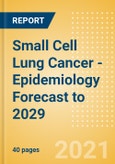Small Cell Lung Cancer - Epidemiology Forecast to 2029
Summary
SCLC accounts for 15% of all lung cancers. SCLC is an aggressive form of lung cancer where approximately 60-70% of patients already have distant metastasis at presentation. SCLC is predominant in elderly populations that are heavy smokers, and the risk of SCLC is proportional to duration and frequency of smoking. Signs and symptoms of SCLC include cough, chest pain, hemoptysis, dyspnea, and weight loss. SCLC has a very poor survival rate, as most of the deaths occur within a year of diagnosis.
The publisher epidemiologists used age- and sex-specific diagnosed incidence and prevalence rates to forecast the diagnosed incident and prevalent cases, taking into account the significant relationship between age and SCLC incidence. the publisher epidemiologists applied country-specific incidence rates of SCLC, wherever available, to each country’s population to obtain the number of estimated diagnosed incident cases.
The following data describes epidemiology of SCLC cases. In 2019, the 8MM had 180,370 diagnosed incident cases of SCLC. This is expected to increase to 243,116 diagnosed incident cases by 2029, at an Annual Growth Rate (AGR) of 3.48%. This increase is partly attributed to the moderately rising trend in incidence in the 8MM, combined with underlying demographic changes in the respective markets. In the 8MM, the five-year diagnosed prevalent cases of SCLC will increase from 153,744 cases in 2019 to 209,944 cases in 2029, at an AGR of 3.66%. The early diagnosis and development of more effective therapies, particularly for elderly patients, would improve survival from SCLC.
Scope
Reasons to Buy
The SCLC Epidemiology series will allow you to -
Summary
SCLC accounts for 15% of all lung cancers. SCLC is an aggressive form of lung cancer where approximately 60-70% of patients already have distant metastasis at presentation. SCLC is predominant in elderly populations that are heavy smokers, and the risk of SCLC is proportional to duration and frequency of smoking. Signs and symptoms of SCLC include cough, chest pain, hemoptysis, dyspnea, and weight loss. SCLC has a very poor survival rate, as most of the deaths occur within a year of diagnosis.
The publisher epidemiologists used age- and sex-specific diagnosed incidence and prevalence rates to forecast the diagnosed incident and prevalent cases, taking into account the significant relationship between age and SCLC incidence. the publisher epidemiologists applied country-specific incidence rates of SCLC, wherever available, to each country’s population to obtain the number of estimated diagnosed incident cases.
The following data describes epidemiology of SCLC cases. In 2019, the 8MM had 180,370 diagnosed incident cases of SCLC. This is expected to increase to 243,116 diagnosed incident cases by 2029, at an Annual Growth Rate (AGR) of 3.48%. This increase is partly attributed to the moderately rising trend in incidence in the 8MM, combined with underlying demographic changes in the respective markets. In the 8MM, the five-year diagnosed prevalent cases of SCLC will increase from 153,744 cases in 2019 to 209,944 cases in 2029, at an AGR of 3.66%. The early diagnosis and development of more effective therapies, particularly for elderly patients, would improve survival from SCLC.
Scope
- Small Cell Lung Cancer(SCLC) Epidemiology Report provides an overview of the risk factors and global trends of SCLC in the eight major markets (8MM: US, France, Germany, Italy, Spain, UK, Japan, and Urban China).
- This report also includes a 10-year epidemiological forecast for the following segmentations in all ages across the 8MM: diagnosed incident cases of SCLC segmented by sex and age (18-29 years, 30-39 years, 40-49 years, 50-59 years, 60-69 years, 70-79 years, and 80 years and older); diagnosed five-year prevalent cases SCLC; diagnosed incident cases of SCLC by cancer staging (limited and extensive); and diagnosed incident cases of SCLC by SLFN11 biomarker.
- The SCLC Epidemiology Report is written and developed by Masters- and PhD-level epidemiologists.
- The Epidemiology Report is in-depth, high quality, transparent and market-driven, providing expert analysis of disease trends in the 8MM.
Reasons to Buy
The SCLC Epidemiology series will allow you to -
- Develop business strategies by understanding the trends shaping and driving the global SCLC market.
- Quantify patient populations in the global SCLC market to improve product design, pricing, and launch plans.
- Organize sales and marketing efforts by identifying the SCLC cancer stages that present the best opportunities for SCLC therapeutics in each of the markets covered.
- Understand magnitude of SCLC market by biomarker.
Table of Contents
1 Table of Contents
2 Small Cell Lung Cancer: Executive Summary
3 Epidemiology
4 Appendix
List of Tables
List of Figures








